Flow Modeling in a Vortex Chamber of a Liquid–Steam Jet Apparatus
Abstract
:1. Introduction
2. Materials and Methods
2.1. Characteristics of Operating Processes
2.2. The Design Schemes of Liquid–Steam Jet Apparatuses
2.3. A Mathematical Model
2.4. Analytical Model
3. Results
3.1. Experimental Results Data
3.2. Computational Model
3.3. Numerical Simulation Results
3.4. Parameter Identification of the Mathematical Model
4. Discussion
- (1)
- a range for the angle δ of flow deviation depending on an arbitrary value of the oblique-cut angle αc has been extended, including a range of 20–60°;
- (2)
- a value of the main parameter n has been clarified based on the proposed analytical dependence (17);
- (3)
- the regression dependence interpolating dataset from Figure 6 has been obtained based on the experimental dependence of the dimensionless radius on the modified Euler number.
5. Conclusions
Author Contributions
Funding
Institutional Review Board Statement
Informed Consent Statement
Data Availability Statement
Acknowledgments
Conflicts of Interest
Nomenclature
| Parameters: | |
| c | velocity, m/s; |
| d | diameter, m; |
| h | specific enthalpy, J/kg; |
| mass flow rate, kg/s; | |
| n | empirical parameter characterizing the irreversibility of the expansion process; |
| p | pressure, Pa; |
| r | radius, m; |
| s | specific entropy, J/(kg∙K); |
| t, τ | time, s; |
| T | temperature, K; |
| ν | specific volume, m3/kg; |
| x | steam dryness degree; |
| α | oblique-cut angle, °; |
| δ | deviation angle, °; |
| Eu | the Euler number; |
| ρ | density, kg/m3; |
| φa | velocity ratio. |
| Indexes: | |
| r | radial component of the flow velocity; |
| u | tangential component of the flow velocity; |
| z | axial component of the flow velocity; |
| I-I | inlet cross-section; |
| II-II | a cross-section of the steady flow. |
References
- Sharapov, S.O.; Arsenyev, V.M.; Kozin, V.M. Application of jet thermal compression for increasing the efficiency of vacuum systems. IOP Conf. Ser. Mater. Sci. Eng. 2017, 233, 012028. [Google Scholar] [CrossRef]
- Arsenyev, V.M.; Sharapov, S.O.; Prokopov, M.G. Influence of the scale factor on the efficiency of a liquid-steam jet compressor. Compress. Power Mach. Ind. 2011, 2, 40–43. [Google Scholar]
- Qin, Z.; Bremhorst, K.; Alehossein, H.; Meyer, T. Simulation of cavitation bubbles in a convergent–divergent nozzle water jet. J. Fluid Mech. 2007, 573, 1–25. [Google Scholar] [CrossRef]
- Ma, J.; Sun, W.; Liu, C.; Hou, Y. Numerical simulation of decompression expansion of subcritical CO2 through converging-diverging nozzle. J. Northeast. Univ. 2013, 34, 1175–1178. [Google Scholar]
- Bulinski, Z.; Smolka, J.; Fic, A.; Banasiak, K.; Nowak, A. A comparison of heterogenous and homogenous models of two-phase transonic compressible CO2 flow through a heat pump ejector. IOP Conf. Ser. Mater. Sci. Eng. 2010, 10, 12–19. [Google Scholar] [CrossRef] [Green Version]
- Chekh, O.; Sharapov, S.; Arsenyev, V. Adiabated flowing streams in nozzles: Influence of regular characteristics on relaxation steam formation. Refrig. Eng. Technol. 2019, 55, 10–14. [Google Scholar] [CrossRef] [Green Version]
- Colarossi, M.; Trask, N.; Schmidt, D.P.; Bergander, M.J. Multidimensional modeling of condensing two-phase ejector flow. Int. J. Refrig. 2012, 35, 290–299. [Google Scholar] [CrossRef] [Green Version]
- Sharapov, S.; Husiev, D.; Panchenko, V.; Kozin, V.; Baha, V. Analysis of the possibility of using R718 for a heat pump of a heating system based on a liquid-vapor ejector. Energy-Sav. Technol. Equip. 2020, 6, 39–44. [Google Scholar] [CrossRef]
- Hemidi, A.; Henry, F.; Leclaire, S.; Seynhaeve, J.M.; Bartosiewicz, Y. CFD analysis of a supersonic air ejector. Part I: Experimental validation of single-phase and two-phase operation. Appl. Therm. Eng. 2009, 29, 1523–1531. [Google Scholar] [CrossRef] [Green Version]
- Liao, Y.; Lucas, D. 3D CFD simulation of flashing flows in a converging-diverging nozzle. Nucl. Eng. Des. 2015, 292, 149–163. [Google Scholar] [CrossRef]
- Zhang, H.; Han, B.; Yu, X.G.; Ju, D.Y. Numerical and experimental studies of cavitation behavior in water-jet cavitation peening processing. Shock Vib. 2013, 20, 895–905. [Google Scholar] [CrossRef]
- Munts, V.A.; Volkova, Y.V.; Plotnikov, N.S.; Dubinin, A.M.; Tuponogov, V.G.; Chernishev, V.A. Studying the characteristics of a 5 kW power installation on solid-oxide fuel cells with steam reforming of natural gas. Therm. Eng. 2015, 62, 779–784. [Google Scholar] [CrossRef]
- Merzliakov, I.S. The Operating Process of the Vortex Liquid-Vapor Jet Unit. Ph.D. Thesis, Sumy State University, Sumy, Ukraine, 2018. [Google Scholar]
- Takahashi, S.; Okuyama, K.; Tamura, A.; Mabuchi, Y.; Kubota, T.; Yoshikawa, K. Development of BWR steam dryer loading evaluation methods through scale model tests under actual steam conditions. Am. Soc. Mech. Eng. 2013, 4, PVP2013-97564. [Google Scholar] [CrossRef]
- Xu, W.; Zhang, T.; Bi, Y.; Li, B.; Liu, W. Analysis of the influence of steam on the measurement characteristics of vortex flowmeter. J. Tianjin Univ. Sci. Technol. 2014, 47, 683–688. [Google Scholar] [CrossRef]
- Li, X.; Wei, Y.J. Numerical simulation for gas-injected cyclone separator by fluid-solid coupling algorithm. Adv. Energy Sci. Equip. Eng. 2015, 3, 2035–2040. [Google Scholar]
- Sadeghiseraji, J.; Moradicheghamahi, J.; Sedaghatkish, A. Investigation of a vortex tube using three different RANS-based turbulence models. J. Therm. Anal. Calorim. 2021, 143, 4039–4056. [Google Scholar] [CrossRef]
- Gnatowska, R.; Sobczyk, J.; Wodziak, W. Stability of flow around two rectangular cylinders in tandem. Acta Phys. Pol. A 2020, 138, 295–298. [Google Scholar] [CrossRef]
- Rogovyi, A.; Korohodskyi, V.; Khovanskyi, S.; Hrechka, I.; Medvediev, Y. Optimal design of vortex chamber pump. J. Phys. Conf. Ser. 2021, 1741, 012018. [Google Scholar] [CrossRef]
- Symak, D.; Atamanyuk, V.; Gumnytskyy, Y. Analysis of dissolution kinetics based on the local isotropic turbulence theory. Chem. Chem. Technol. 2015, 9, 493–496. [Google Scholar] [CrossRef] [Green Version]
- Tseitlin, M.; Raiko, V.; Shestopalov, O. Heat Exchange Characteristics of Trays for Concentrating Solutions in Direct Contact with Hot Gas Emissions. In Advances in Design, Simulation and Manufacturing III, Proceedings of the 3rd International Conference “Design, Simulation, Manufacturing: The Innovation Exchange (DSMIE 2020)”, Kharkiv, Ukraine, 9–12 June 2020; Ivanov, V., Pavlenko, I., Liaposhchenko, O., Machado, J., Edl, M., Eds.; Lecture Notes in Mechanical Engineering; Springer: Cham, Switzerland, 2020; pp. 396–404. [Google Scholar] [CrossRef]
- Bondar, A.V.; Vaneev, S.M. Research of working process of vortex expansion machine with side channel. J. Eng. Sci. 2018, 5, E5–E9. [Google Scholar] [CrossRef]
- Kim, D.; Kim, D. Free-surface vortex formation and aeration by a submerged rotating disk. Chem. Eng. Sci. 2021, 243, 116787. [Google Scholar] [CrossRef]
- Prokopov, M.G.; Kozin, V.N.; Merzliakov, I.S. Influence of a nozzle’s oblique cut on the formation of a vortex flow in a vortex-type liquid-steam jet compressor. Compress. Power Mach. Ind. 2015, 4, 20–24. [Google Scholar]
- Prokopov, M.G. Thermophysical Modeling of the Working Process of a Liquid-Steam Jet Compressor. Master’s Thesis, Sumy State University, Sumy, Ukraine, 2011. [Google Scholar]
- Grosheintz-Laval, L.; Käppeli, R. Well-balanced finite volume schemes for nearly steady adiabatic flows. J. Comput. Phys. 2020, 423, 109802. [Google Scholar] [CrossRef]
- Wang, Y.; Hu, Z.; Zhang, K.; Deng, K.; Qian, Y.; Liu, B. Research on multi-branch momentum conservation boundary model for internal combustion engine manifolds. Chin. Intern. Combust. Engine Eng. 2021, 42, 53–59. [Google Scholar] [CrossRef]
- Rashkovan, A.; Amar, S.D.; Bieder, U.; Ziskind, G. Analysis of polygonal vortex flows in a cylinder with a rotating bottom. Appl. Sci. 2021, 11, 1348. [Google Scholar] [CrossRef]
- Merzliakov, I.; Pavlenko, I.; Chekh, O.; Sharapov, S.; Ivanov, V. Mathematical modeling of operating process and technological features for designing the vortex type liquid-vapor jet apparatus. In Advances in Design, Simulation and Manufacturing II (DSMIE 2019), Lutsk, Ukraine, 11–14 June 2019; Ivanov, V., Trojanowska, J., Machado, J., Liaposhchenko, O., Zajac, J., Pavlenko, I., Edl, M., Perakovic, D., Eds.; Lecture Notes in Mechanical Engineering; Springer: Cham, Switzerland, 2020; pp. 613–622. [Google Scholar] [CrossRef]
- Ershkov, S.V.; Prosviryakov, E.Y.; Burmasheva, N.V.; Christianto, V. Towards understanding the algorithms for solving the Navier-Stokes equations. Fluid Dyn. Res. 2021, 53, 044501. [Google Scholar] [CrossRef]
- Ishak, M.H.H.; Ismail, F.; Mat, S.C.; Abdullah, M.Z.; Abdul Aziz, M.S.; Idroas, M.Y. Numerical analysis of nozzle flow and spray characteristics from different nozzles using diesel and biofuel blends. Energies 2019, 12, 281. [Google Scholar] [CrossRef] [Green Version]
- Pavlenko, I.; Liaposhchenko, O.; Pitel, J.; Sklabinskyi, V. Parameter identification of the Basset force acting on particles in fluid flow induced by the oscillating wall. J. Appl. Math. Comput. Mech. 2019, 18, 53–63. [Google Scholar] [CrossRef]
- Ali, A.; Si, Q.; Yuan, J.; Shen, C.; Cao, R.; Saad AlGarni, T.; Awais, M.; Aslam, B. Investigation of energy performance, internal flow and noise characteristics of miniature drainage pump under water–air multiphase flow: Design and part load conditions. Int. J. Environ. Sci. Technol. 2021, 116, 1–18. [Google Scholar] [CrossRef]
- Lin, M.; Cheng, C.; Peng, Z.; Dong, X.; Qu, Y.; Meng, G. Nonlinear dynamical system identification using the sparse regression and separable least squares methods. J. Sound Vib. 2021, 505, 116141. [Google Scholar] [CrossRef]
- Qin, L.; Xiang, Y.; Qin, S.; Liu, H. On the structures of compressible vortex rings generated by the compressible starting jet from converging and diverging nozzles. Aerosp. Sci. Technol. 2020, 106, 106188. [Google Scholar] [CrossRef]
- Javadi, A.; Nilsson, H. Active flow control of the vortex rope and pressure pulsations in a swirl generator. Eng. Appl. Comput. Fluid Mech. 2017, 11, 30–41. [Google Scholar] [CrossRef] [Green Version]
- Xiang, Y.; Qin, S.; Liu, H. Patterns for efficient propulsion during the energy evolution of vortex rings. Eur. J. Mech. 2018, 71, 47–58. [Google Scholar] [CrossRef]
- Zhou, K.; Qin, X.; Zhang, L.; Wu, Y. An experimental study of jet fires in rotating flow fields. Combust. Flame 2019, 210, 193–203. [Google Scholar] [CrossRef]
- Volov, V.T.; Lyaskin, A.S. Investigation of the cascade mechanism of energy exchange in swirling gas flows based on the effect of secondary swirling. J. Phys. Conf. Ser. 2020, 1677, 012032. [Google Scholar] [CrossRef]
- Baghel, K.; Sridharan, A.; Murallidharan, S.J. Heat transfer characteristics of free surface water jet impingement on a curved surface. Int. J. Heat Mass Transf. 2021, 164, 120487. [Google Scholar] [CrossRef]
- Santhanakrishnan, R.; Sundararaj, K. Numerical investigation of a round jet normal to a crossflow: Application to pollutant dispersion. Ecol. Environ. Conserv. 2018, 24, S164–S168. [Google Scholar]

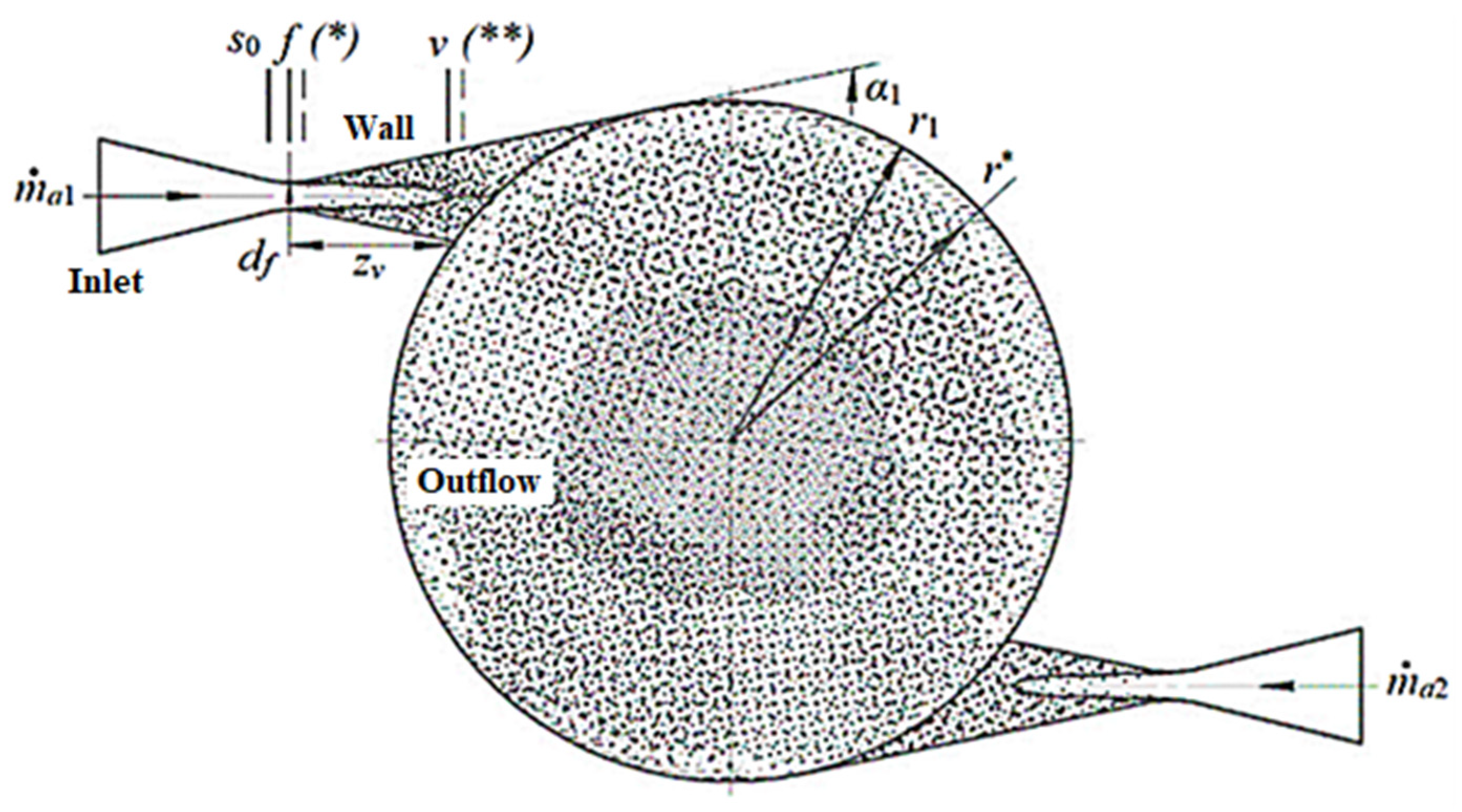

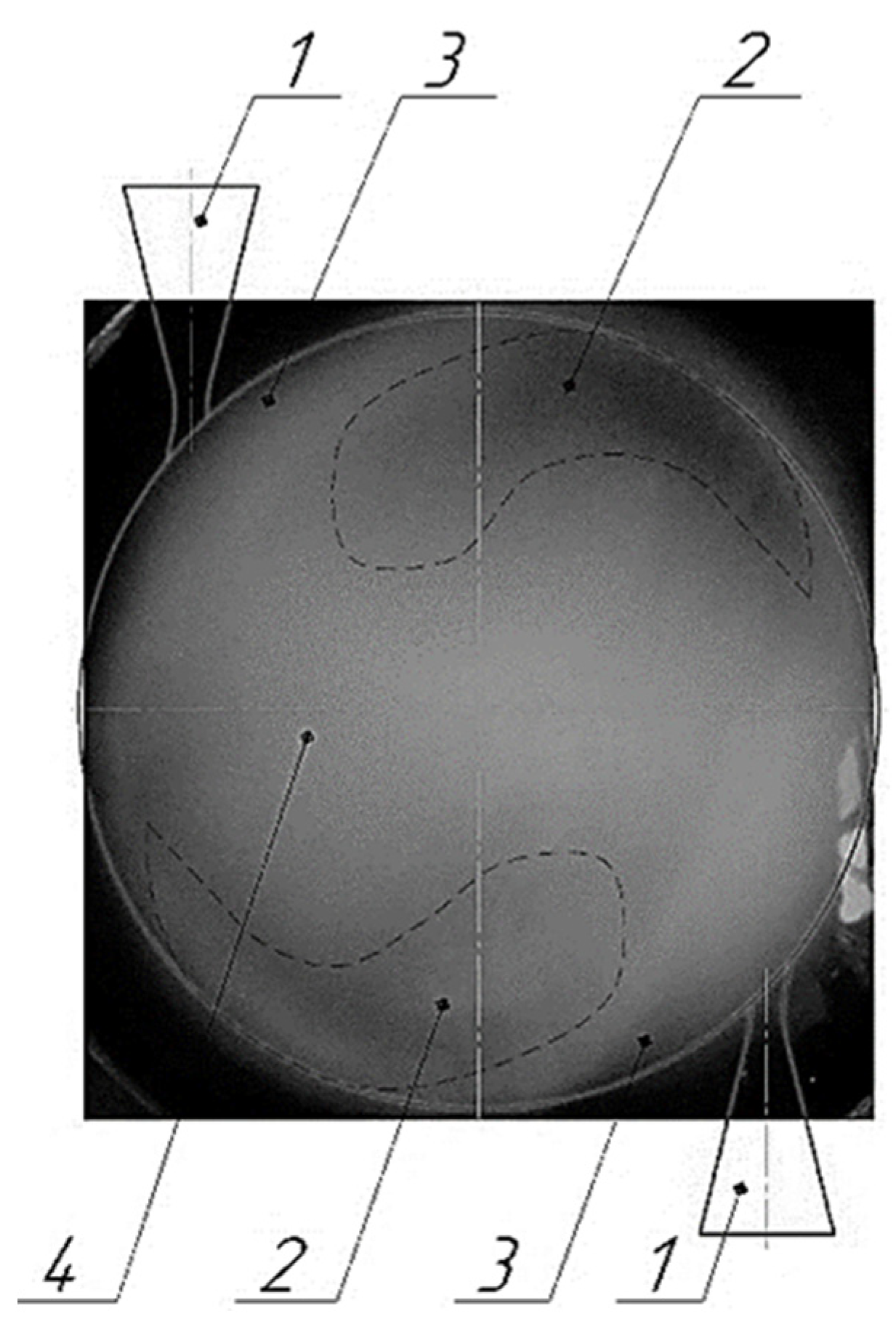
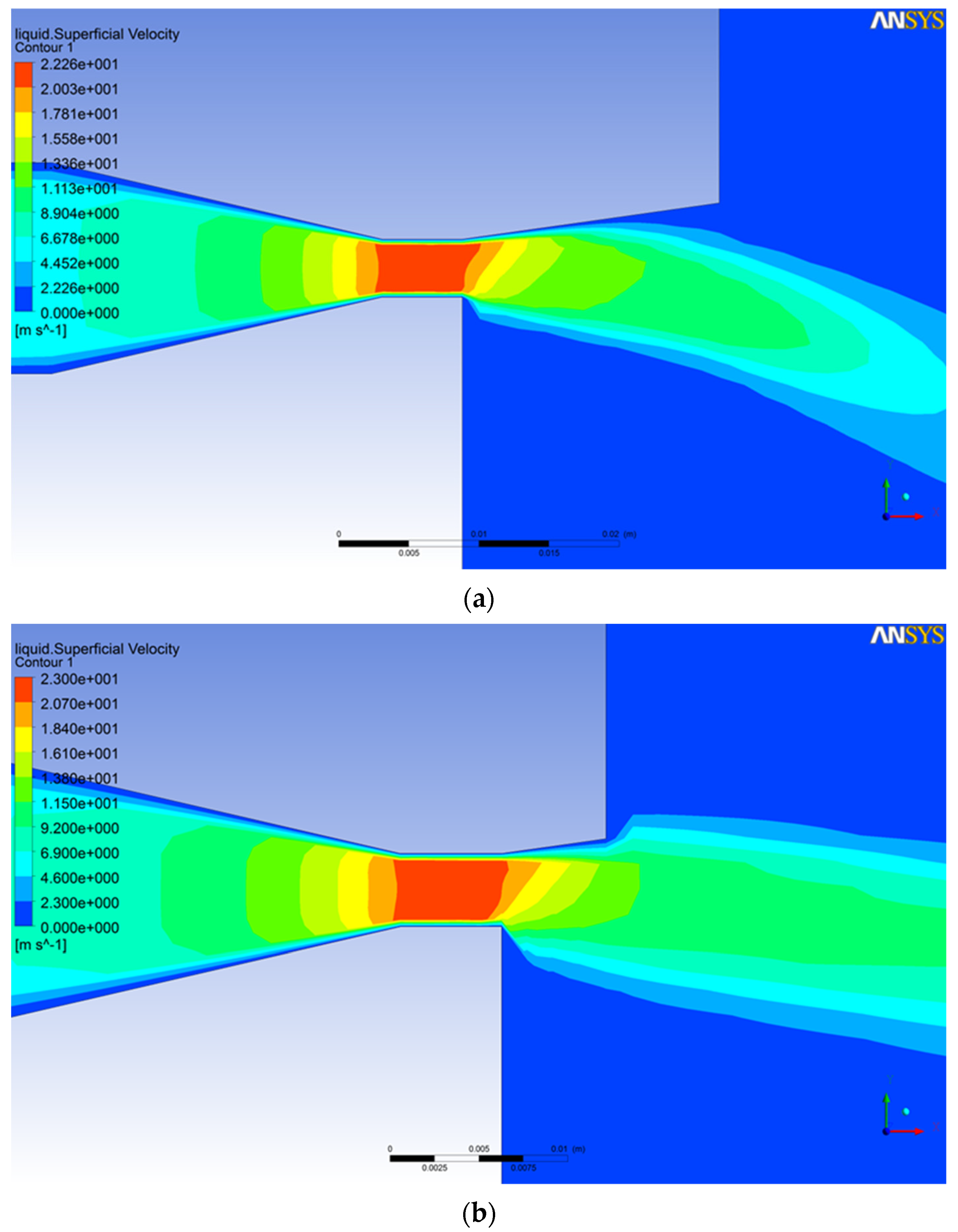


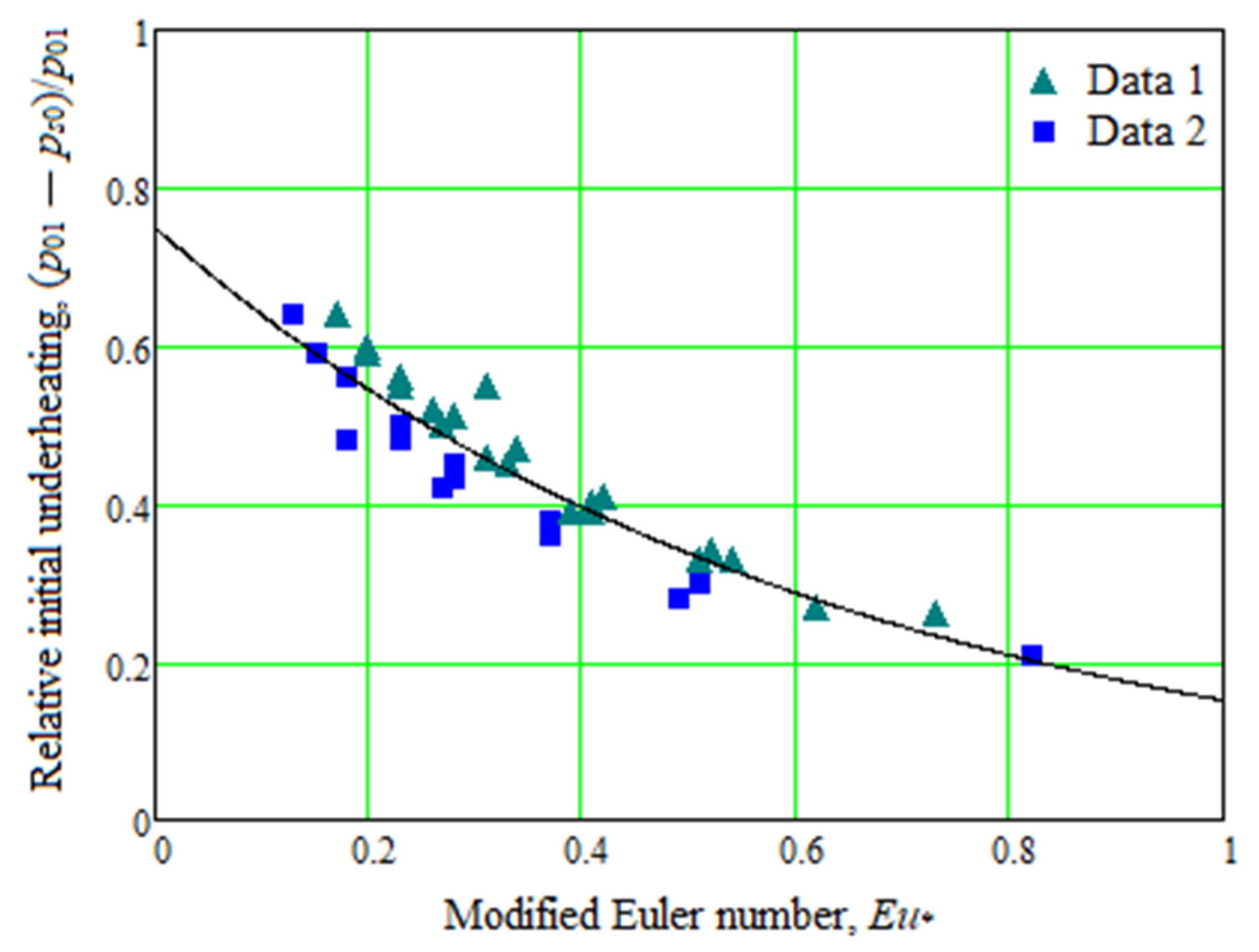
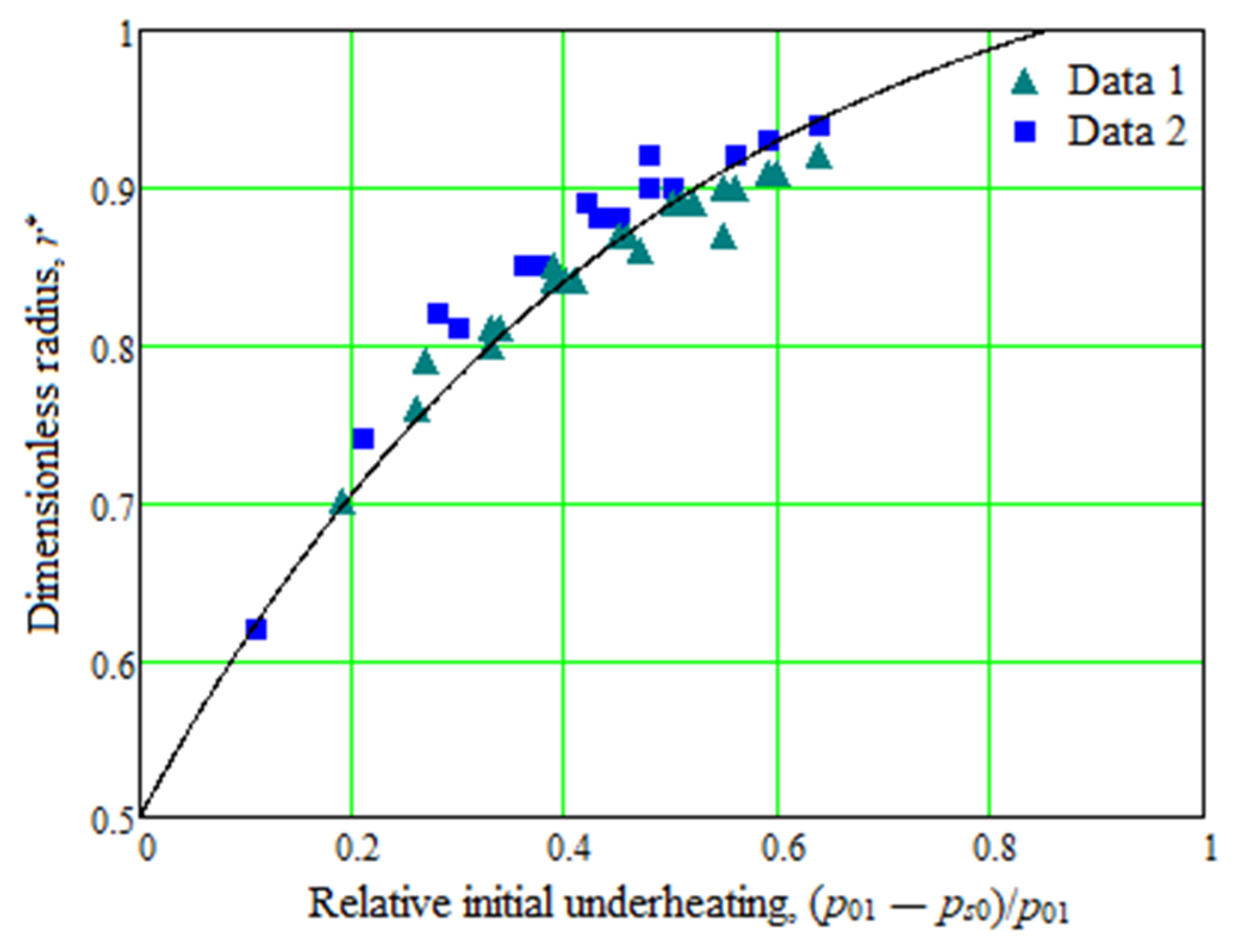
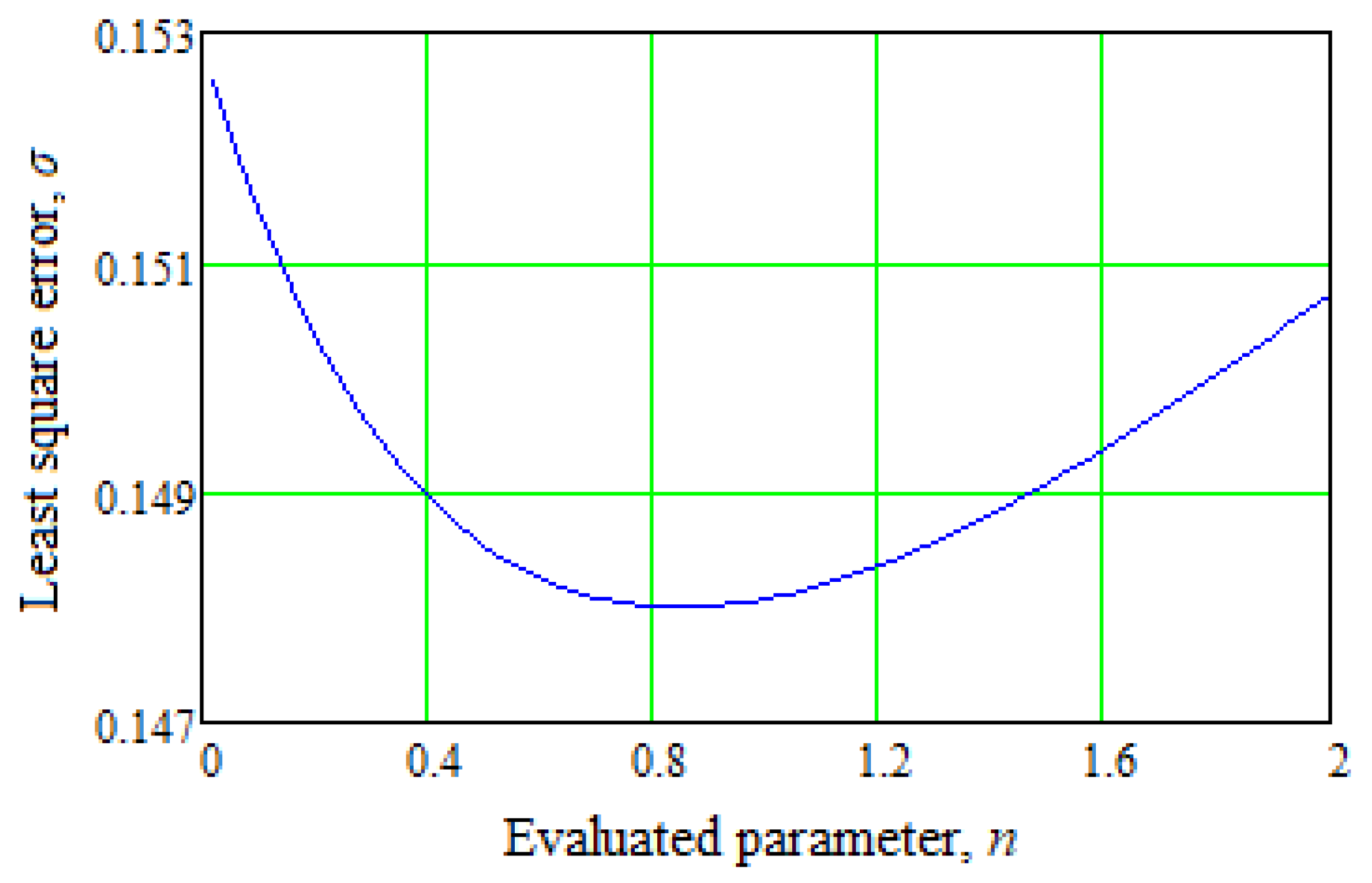
| Type | The Design Scheme | Type | The Design Scheme |
|---|---|---|---|
| Spiral round |  | Tangential |  |
| Spiral rectangular |  | Dual-nozzle tangential |  |
| Spiral tapered |  | Multi-nozzle tangential |  |
| Critical Cross-Section Diameter, df, mm | Oblique Cut Angle, α, ° | The Taper Angle of the Nozzle, α1, ° | Flow Deflection Angle, δ, ° | Transition through the First Critical Section (*) |
|---|---|---|---|---|
| 4.1 | 20 | 16.0 | 27 | + |
| 25 | 26 | + | ||
| 30 | 24 | + | ||
| 35 | 22 | + | ||
| 40 | 20 | + | ||
| 45 | 19 | + | ||
| 50 | 15 | – | ||
| 55 | 13 | – | ||
| 60 | 12 | – |
Publisher’s Note: MDPI stays neutral with regard to jurisdictional claims in published maps and institutional affiliations. |
© 2022 by the authors. Licensee MDPI, Basel, Switzerland. This article is an open access article distributed under the terms and conditions of the Creative Commons Attribution (CC BY) license (https://creativecommons.org/licenses/by/4.0/).
Share and Cite
Merzliakov, I.; Pavlenko, I.; Ochowiak, M.; Ivanov, V.; Agarwal, P. Flow Modeling in a Vortex Chamber of a Liquid–Steam Jet Apparatus. Processes 2022, 10, 984. https://doi.org/10.3390/pr10050984
Merzliakov I, Pavlenko I, Ochowiak M, Ivanov V, Agarwal P. Flow Modeling in a Vortex Chamber of a Liquid–Steam Jet Apparatus. Processes. 2022; 10(5):984. https://doi.org/10.3390/pr10050984
Chicago/Turabian StyleMerzliakov, Iurii, Ivan Pavlenko, Marek Ochowiak, Vitalii Ivanov, and Praveen Agarwal. 2022. "Flow Modeling in a Vortex Chamber of a Liquid–Steam Jet Apparatus" Processes 10, no. 5: 984. https://doi.org/10.3390/pr10050984









